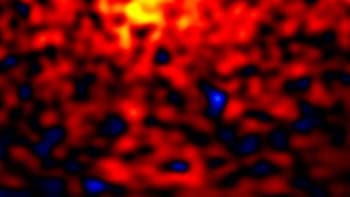
Streams of dark matter interacting with rivers of stars could provide astrophysicists with important information about the distribution and make-up of dark matter in the halo of the Milky Way. That’s the conclusion of Jo Bovy of the University of Toronto, who has calculated that it should be possible to observe the effects of dark matter on the stellar streams that are known to encircle our galaxy.
The theory of cold dark matter (CDM) is one of the cornerstones in our understanding of the evolution of structure in the universe. It posits that the haloes surrounding galaxies such as the Milky Way should be clumpy, with myriad blobs of dark matter held together by gravity. The Milky Way’s halo is also home to a swarm of globular star clusters and dwarf galaxies, some of which are being torn apart by gravitational tidal forces to create streams of stars that can stretch halfway around the galaxy.
For more than a decade, astrophysicists have suspected that dark-matter clumps could be detected by observing how their gravitational pull affects the motions of stars in stellar streams. Sceptics, however, point out that the Milky Way’s gravity can also stretch the dark-matter clumps into long streams – and it would be much more difficult to observe the effect of such dark-matter streams on stellar streams.
Mapping in 3D
Now, new research by Bovy suggests that streams of dark matter can still be detected through their interactions with stellar streams pulled from globular clusters. His calculations reveal that careful measurements of the motions of stars within these stellar streams could reveal the presence of dark-matter streams. These dark-matter streams could then be traced back to the clumps of dark matter that feed them. Ultimately, it should be possible to create a 3D map of dark matter in the Milky Way halo, he argues.
“I think it’s one of the only ways where we can actually measure whether these little clumps of dark matter truly exist in the haloes of galaxies,” Bovy told physicsworld.com. He also says that such measurements provide an excellent opportunity to study the nature of dark matter and work out if dark matter is indeed “cold”.
Tiny clumps
CDM refers to hypothetical dark-matter particles that move much slower than the speed of light. This sluggishness should allow gravity to group CDM particles into relatively small clumps. While CDM is currently the most popular description of dark matter, an alternative theory is that dark matter is “warm” and hence moves faster than CDM. Warm dark matter would still be able to form clumps, depending on the energy of the particles, but these clumps would be no smaller than the smallest galaxies.
Bovy points out that the motion of the stellar streams should be able to reveal clumps of dark matter as small as 10 million times the mass of the Sun. If small clumps are found, this would be strong evidence that dark matter is indeed CDM.
“If [Bovy] is correct that the dark-matter clumps can be detected using streams, then that would be terrific,” enthuses Kathryn Johnston of Columbia University in New York. In 2002 Johnston was part of a team that first suggested that undisturbed dark-matter clumps could be detected via stellar streams. “Our halo is the one place in the universe where I think we can really test this,” she says.
Data deluge
Astronomers have so far discovered about two dozen stellar streams. They are not easy to find because they appear merely as over-densities of background stars in images obtained by the Sloan Digital Sky Survey telescope in New Mexico. The European Space Agency’s Gaia mission, which is measuring the positions and motions of a billion stars, will help find new streams, as will the upcoming Large Synoptic Survey Telescope (LSST) currently under construction in Chile.
Johnston says that “the amazing data sets on the horizon from Gaia and LSST” are encouraging astrophysicists to focus on stellar streams. “We have real data coming, which means we must develop robust methods to measure the streams,” she says.
Bovy agrees: “I think it’s a very exciting area. The next few years, especially with the data from the Gaia satellite, are going to be of particular interest to the greater physics community, as this is one of the ways we can actually learn something new about dark matter.”
Bovy’s research is described in Physical Review Letters.



